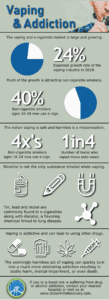E-cigarettes and vaping have seen an exponential rise in recent years, as people look to replace their addiction to smoking cigarettes with something that claims to be less harmful. On the surface, vaping can seem like a much less dangerous activity to engage in, as nicotine is delivered to the individual through water vapor instead of through smoke and combustion. But although this may be less harmful than traditional cigarettes, vaping and addiction are realities that should not be overlooked.
Before diving head first into this habit, it’s essential to understand not only how vaping can affect your health, but how it can open to doors to potential other addictions.
Is Vaping Harmless?
The notion that vaping is safe and harmless is a misconception, and this belief can be especially harmful to our youth. Unfortunately, vaping nicotine is not a safe or healthy habit to engage in, as it can have several adverse health consequences.
Many e-cigarettes contain more than just nicotine in vapor forms. Not only is does vaping include nicotine, but it can also contain things such as ultrafine particles that can be inhaled deep into the lungs while vaping.
E-cigs can also hold substances such as heavy metals, including nickel, tin, and lead, things which can have serious adverse health consequences. E-cigarettes have also been known to contain items such as diacetyl, a flavor compound that has been linked to severe lung disease.
Additionally, vaping can include consuming volatile organic compounds, which can contribute to a reduction in overall lung health.
Deceptive Marketing to Young People
Big Tobacco has seen the writing on the wall, which is why big-name vaping brands such as Juul, Vuse, and others are owned by big tobacco companies. As more people kick smoking to the curb, vaping is seen as the next big growth market in the nicotine industry, as vaping was expected to increase by 24% in 2018.
A recent study of 12th graders[1] found that teens who vaped were more than four times as likely to move away from the perception that cigarettes posed a severe health risk. This illustrates how vaping can damage the perception of tobacco being an adverse health concern.
Vaping is marketed to young (and old) people as being a less dangerous, less addictive, more accessible version of smoking, which can make it seem like a harmless activity as a result. Because vaping is a recent phenomenon, there is simply not enough research to conclude that this is a safe and harmless activity. This fact should not be overlooked, as a person shouldn’t merely rely on the best-case-scenario to guide them with their health. As we’ve seen with smoking and tobacco, research may end up showing that vaping can lead to cancer, respiratory issues, and other health conditions which can make the act of vaping a very harmful act.
Continued after infographic:
Vaping Can Lead to Other Forms of Addiction
Vaping is often seen as a harmless activity. The wide availability of fruit-inspired varieties that appeal to a younger market disguise the fact that the key ingredient is still nicotine. Vaping has seen an increase within the younger section of the population, as usage among high schoolers has risen from less than 5% in 2011 to over 20% as of 2018[2].
Nicotine is unsafe at any age, but particularly dangerous before the age of 25 as the brain is fully developing until then. The brain will begin to crave the “feel good” reward that nicotine delivers as it is inhaled.
Often, this leads them to try other substances such as alcohol or other drugs that can deliver the same high. Vaping at a young age has been shown to increase the likelihood of an individual using marijuana in the future as well. More than 1 in 4 teens who reported vaping eventually moved on to smoking pot[3]. The seemingly harmless act of vaping can quickly turn to a debilitating addiction.
Although vaping is often marketed as a safer alternative to smoking, it can actually lead teens to eventually smoke cigarettes as well. A 2018 National Academy of Medicine article reported[4] there was evidence that e-cigarette use can increase the frequency and amount of cigarette smoking in the future.
Continued after video:
Seek Assistance Before Your Condition Gets Worse
Casual use of e-cigs can quickly develop into a full-blown dependent behavior, something which can create physical, mental, and financial stress. Vaping and addiction are things that are serious and need to be dealt with. As previously stated, it can lead to many other adverse health outcomes, especially if one decides to engage in other forms of substance use. Before things get out of hand, it’s always wise to seek help from trusted, professional sources.
Vaping may seem relatively insignificant when compared with other forms of addiction, but addictive behavior is still something that can create adverse life outcomes and should be addressed as soon as possible. Peer support and one-on-one therapy can be extremely beneficial with individuals struggling with an addiction, and this is no different when it comes to vaping and nicotine.
If you or someone you love is seeking addiction treatment, contact the caring professionals of Ocean Hills Recovery. We have worked directly with clients to assist them on their path to recovery, and we provide realistic and sustainable solutions that will last long beyond the treatment center.
Contact Ocean Hills Recovery today to begin your recovery and achieve the life you deserve.
Sources:
[1] https://www.healthline.com/health-news/tobacco-companies-taking-over-e-cigarette
[2] https://e-cigarettes.surgeongeneral.gov/
[3] https://consumer.healthday.com/cancer-information-5/electronic-cigarettes-970/could-vaping-lead-teens-to-pot-smoking-733155.html
[4] https://www.healthline.com/health-news/tobacco-companies-taking-over-e-cigarette#3














